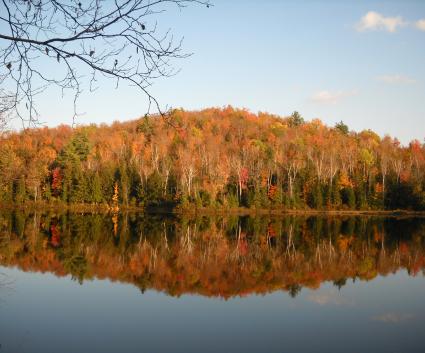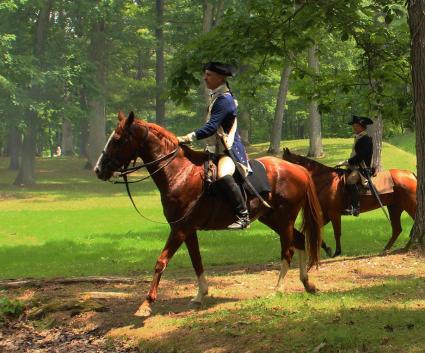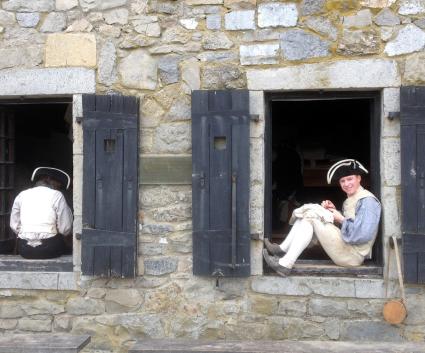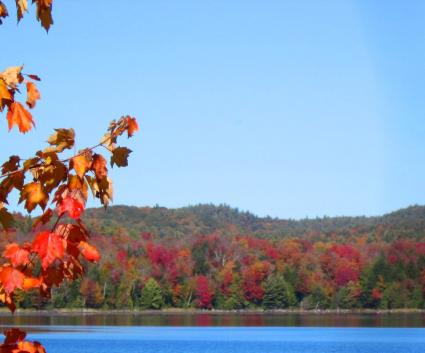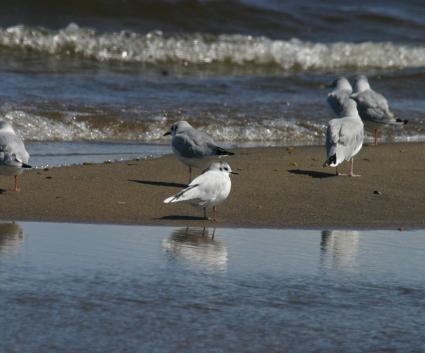It might seem like an unpromising time for exploration. An in-between time -- past the hiking trails of summer and not yet consistently fluffy enough for the snowshoeing and cross-country trails of deep winter.
But with the right preparation and an adventurous mindset, these times can be just as rewarding. They offer advantages that happen only in those in-between times.
You could, like me, become a fan of between season hiking. As seen on a recent hike to Belfry Mountain and its fire tower.

Choose change
You love a new trail because you don't know what to expect. This same quality can make an old trail... new again. Because if there is one thing good to know about in-between times, it is being prepared for the unexpected.
Like the beauty of many seasons, combined. There are only a few times a year that this fleeting scene can be photographed.

You should check the forecast, and expect it to change. You should dress for the trailhead, and be ready for a different climate at the summit. You should plan to get back in plenty of time, but also be ready with lights in the backpack.
Always a backpack.

This is where to store the headlamp or flashlights. Did you test them and grab extra batteries? Because if you don't, you might become one of those people that tell me stories that end, "So we spent the night in the woods..." Because this is the Adirondacks. When it gets dark, it gets very dark indeed.
I had this brought to my attention when I found myself walking along a gravel road, in the woods, after dark. In a few minutes, I was in woods so deep even the starlight did not get down to me, so I had to listen to my footsteps on the gravel to make sure I was still on the road. This is how I managed to reach the meadow full of starlight and find my car.
On the trails, there isn't any gravel to crunch. Usually. However, Belfry Mountain has some unique advantages, since the trail is an old gravel road. But on a day like today, that layer is held in some frozen ground, or actual ice.

Also, note the difference in the light. Sunset is a couple of hours away, but the evergreen forest looks deep and dark, because the sunlight is already quite slanted. At this point in the trail, the light is only full strength on the distant mountains.
Choose wisely
Remember that turning back is always an option if a hike is running late. This trail is only .4 miles to the fire tower, so there should be plenty of time to summit and get down well ahead of dusk - depending on when you leave.
But hurrying is always a bad idea, so leave yourself enough time - research indicates that it's the return from the peak that is an especially tricky time. For one thing, gravity is against you. Going uphill, you are leaning over, more centered on your feet. Going downhill, you lean back. This balances the weight, unless a pebble rolls out from under your foot or you catch your foot on a root. Then, you are off-balance, and more likely to fall.

So the sensible hiker in these conditions uses a walking stick or trekking pole to help maintain balance. This also spares your knees from all the impact of descent. Oh, your knees don't bother you? Take precautions, and things will stay that way.
This is an easy hike in another important way. It is not steep. There are even some level areas. At the crossroads, as seen above, keep going straight, as the trail markers indicate. Soon, there is a glimpse of the destination.

My companion and I are warmly dressed, because it is a chilly, but bright, day. Throughout the trail, we have set a brisk pace and both of us drop our headgear. Gloves, not mittens, are perfecty adequate. But once we reach the summit, that will change. The trail was still, with woods on both sides sheltering us. At the top, there is wind, and the well-known chill factor.
This is where that backpack full of the right layers and accessories will mean the difference between an uncomfortable time, and a delightful one. This is also the time of year to drop summer's cotton and embrace the insulating and water shedding virtures of wool and polar fleece.
Not fleece as in what sheep wear, but the type of polyester fabric dear to my heart because my skin can't handle wool. If yours can, wool is a great choice because it can keep you warm even when it is wet. Fleece sheds water because it is essentially plastic, and will dry quickly.

This is important because of the danger of hypothermia, which can seem quite distant when we are dry and warm. But unless you have experienced the one-two punch of a cold wind and wet clothing, it can take anyone by surprise. Even if the outside temperature is as high as 65 degrees, it can still happen.
So that outfit that worked fine at the beginning of the hike, even if nothing else changes, might be not warm enough by the end.
Choose action
Mindful that the wind will only increase as we go higher, we bundle up and resume the climb.

Choose the path at the right of this picture, to go over rocks without snow and ice on them. This is always something to consider when hiking in-between. In summer, the rocks can be scrambled over wherever it looks good. In winter, snow might completely cover them. But here, at the cusp of two seasons, there can be ice.
If I thought it was windy at the summit, that is because I haven't climbed the tower yet. It features sturdy wooden stairs with handrails and wire mesh between the struts. And a good thing, too, because the wind increases at every step. Once in the windowless fire tower, we have to brace ourselves to get clear photos.

But what a gorgeous view it is. Why should we deprive ourselves because the weather has not settled into a single mode? I can't think of a reason.

As seen below, the change of seasons offers varying layers of nature. Simultaneously, while layers of protection let us handle changes in the environment. Layers of micro-climates pop out when viewed with enough distance.

Because there isn't a reason to deprive ourselves of nature. That is the Adirondack way.
I hope you feel the same.
Look forward to a nice place to stay. Fuel up with our dining. Explore another great hike.


